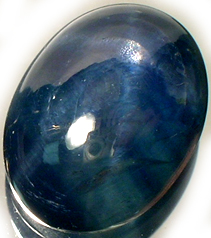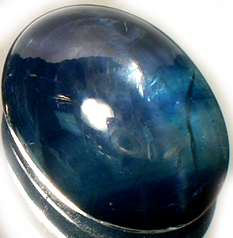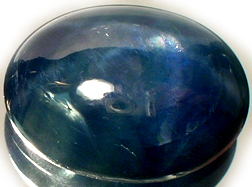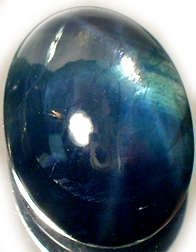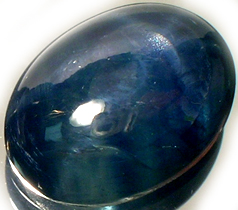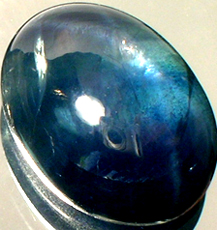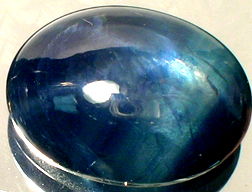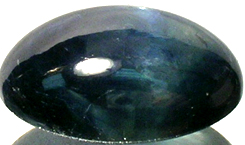|
19thC Antique 4 1/2ct Navy Blue Star Sapphire Oval Gemstone 12mm*9mm - $199.99
For Customers outside of USA 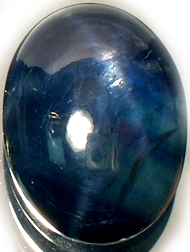
Antique Genuine Natural Burmese Four and One-Half Carat Navy Blue Perfect Star Sapphire Oval. CLASSIFICATION: Cabochon Blue Star Sapphire Oval. ORIGIN: Mogok, Burma (present day Myanmar). 19th Century. SIZE: Length: 12mm. Width: 9mm. Depth: 4.5mm. All measurements approximate. WEIGHT: 4.51 carats. NOTES: Upon request we can set your gemstone as a ring, earring, or pendant.
DETAIL: A gorgeous and richly colored Navy blue colored star sapphire precious gemstone from Mogok, Burma. This particular specimen is a beautiful Navy blue with violet undertones - very reminiscent of a late summer's afternoon Navy, just as twilight approaches. It is quite striking, very handsome and rich in tone, the color intense yet still delicate, the star quite beautiful. The gemstone was hand shaped and polished into this very beautiful oval cabochon by a 19th century Russian artisan for use in domestic jewelry. The result is an exquisite and incredibly richly colored precious gemstone with lots of depth and gorgeous tone. It is not an absolutely flawless gemstone. Of course it is the alignment of included material which creates the star - so star sapphires always have included material. The question is, how noticeable? With this particular specimen, to the eye, there are no significant blemishes. However with photo enlargement - or examination with a jeweler's loupe, one can detect very slight color zoning. This means you might notice a slight variations in the tone, as well as a few internal blemishes. However to the eye it is quite beautiful and without flaw. It is only when you examine it under magnification you might be able to pick out some very minor color zoning and a minute blemish or two. Of course, the same can be said of most sapphires in general, and particularly star sapphires. Color zoning is quite common in sapphires, and unless very obvious, is generally not seriously detrimental.
Known as a "star" sapphire because of an optical effect known as an "asterism"; oriented crystal inclusions cause this six-rayed-star light effect (the asterism) to form on the surface of these beautiful precious gemstones. Star sapphires have been produced in Mogok, Burma in limited quantities for centuries. They are perhaps 100 times as rare as an ordinary sapphire. The highest quality specimens will be more transparent, lower quality specimens more opaque. Higher quality gemstones will exhibit a more pronounced asterism, lower quality specimens will not. Lower quality specimens will be heavily included, higher quality specimens will have fewer, smaller inclusions. Good quality star sapphires are in high demand, especially those in color other than navy blue or black, and can be quite costly. Consequentially, many of the star sapphires sold at retail are synthetic - check the fine print!
Under magnification the gemstone shows the unmistakable characteristics of having been hand crafted. The coarseness of the 19th century finish is considered appealing to most gemstone collectors, and is not considered a detriment, or detract from the value of a gemstone. In fact most serious collectors consider such gemstones more desirable, possessed of greater character and uniqueness when compared to today's cookie-cutter mass-produced machine-tumbled gemstones. Unlike today's computer controlled machine produced gemstones, the cut and finish of a gemstone such as this is the legacy of an artisan who lived two centuries ago. This gemstone has great luster and sparkle, and to the eye is more or less transparent, but it is not entirely flawless. True, the blemishes it possesses are near invisible to the naked eye. However magnified 400%-500%, as it is here, you can see slight imperfections (included material), and the afore-mentioned color zoning within the gemstone and occasional irregularities in the finish.
Keep in mind however that these characteristics are not only expected of hand-finished gemstones, you must also consider that two centuries ago the mining techniques even possible then, let alone in practice, did not allow the ultra deep mining operations which are so prevalent today. Two centuries ago mankind was more or less limited to surface deposits or near surface deposits of gemstones. Higher quality gemstones which today are routinely mined from beneath hundreds of meters, even kilometers beneath the earth's surface, were simply inaccessible then. So antique gemstone must be appreciated as antiques first, gemstones second. The relatively superlative quality of gemstones routinely mined from deep beneath the earth's surface today were simply not accessible two centuries ago, or at least, only rarely so. However for most, the unique nature and character of antique gemstones such as this more than makes up for included imperfections which by and large, are only visible under magnification.
HISTORY: Mentions of sapphire in ancient references reach well back past 800 B.C. Certainly the ancient Greeks, Persians, and Romans all knew of blue sapphires and employed the precious gemstones in their jewelry. In the world of the ancient Mediterranean, priests and sorcerers honored the sapphire above all other gems. As the centuries passed, European royalty came to highly favor sapphires believing the stone would provide protection from harm. In the medieval world blue sapphires were believed to represent heaven, and thus the precious gemstones were widely used in ecclesiastical jewelry. Sapphires are a member of the corundum family, as are rubies, and as such sapphires are considered one of the most valuable of precious stones. They are also extremely hard, second only to diamonds, and so are very popular as gemstones for rings and pendants. Sapphires are mined in Thailand, Ceylon, Burma, Australia, Madagascar, Russia, South Africa, China, Afghanistan, and in Montana and North Carolina.
SHIPPING OPTIONS: All purchases are backed by an unlimited guarantee of satisfaction and authenticity. If for any reason you are not entirely satisfied with your purchase, you may return it for a complete and immediate refund of your entire purchase price. Most of these antique gemstones were originally part of two collections, one originating in India principally composed of gemstones originally mined in India, Burma, Ceylon, and Siam, and then hand faceted in India. The addition of a second accumulation of antique gemstones originally mined in the Urals in the mid to late 19th century (including alexandrite) completed the collection. These gemstones as well were hand finished. The Urals have been one of the world's major sources of precious and semi-precious gemstones for many centuries. As well, additional specimens are occasionally acquired from other institutions and dealers in Eastern Europe and Asia. These antique gemstones are now in the United States and are available for immediate delivery. We ship inventory from the USA order fulfillment center near Seattle, Washington. Your purchase will ordinarily be shipping within 48 hours of payment. A certificate of authenticity is available upon request. We prefer your personal check or money order over any other form of payment - and we will ship immediately upon receipt of your check (no "holds"). We will accept PayPal payments. Please see our "ADDITIONAL TERMS OF SALE".
|
|---|
